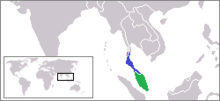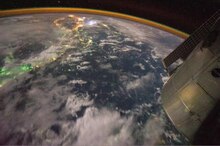Malay Peninsula
From Wikipedia, the free encyclopedia
The Malay Peninsula (Malay: Semenanjung Tanah Melayu, سمننجوڠ تانه ملايو ; Thai: คาบสมุทรมลายู rtgs: Khapsamut Malayu) is a peninsula in Southeast Asia. The land mass runs approximately north-south and, at its terminus, is the southernmost point of the Asian mainland. The area contains the southernmost tip of Myanmar, Peninsular Malaysia, and Southern Thailand.
The Titiwangsa Mountains are part of the Tenasserim Hills system, and form the backbone of the Peninsula. They form the southernmost section of the central cordillera which runs from Tibet through the Kra Isthmus (the Peninsula's narrowest point) into the Malay Peninsula.[1] The Strait of Malacca separates the Malay Peninsula from the Indonesian island of Sumatra while the south coast is separated from the island of Singapore by the Straits of Johor.
Contents
[hide]Etymology[edit]
The Malay term Tanah Melayu is derived from the word Tanah (land) and Melayu (Malays), thus it means "the Malay land". The term can be found in various pre-modern Malay texts, of which the oldest dating back to the early 17th century.[2] It is frequently mentioned in the Hikayat Hang Tuah, a well known classical work that began as oral tales associated with the legendary heroes of Melaka Sultanate. Tanah Melayu in the text is consistently employed to refer to the area under Melakan dominance.[3] In the early 16th century, Tomé Pires, a Portuguese apothecary who stayed in Melaka from 1512 to 1515, writes an almost identical term, Terra de Tana Malaio which he referred to the southeastern part of Sumatra, where the deposed Sultan of Melaka, Mahmud Shah established his exiled government. The 17th century's account of Portuguese historian, Emanuel Godinho de Erédia, noted on the region of "Malaios" surrounded by the Andaman Sea in the north, the entire Malacca Strait in the centre, a part of Sunda Strait in the south, and the western part of South China Sea in the east.[4]
P



No comments:
Post a Comment